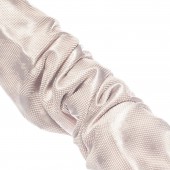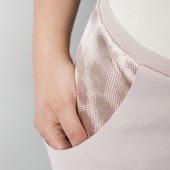
| THE AWARD |
| CATEGORIES |
| REGISTRATION |
| SUBMIT YOUR WORK |
| ENTRY INSTRUCTIONS |
| TERMS & CONDITIONS |
| PUBLICATIONS |
| DATES & FEES |
| METHODOLOGY |
| CONTACT |
| WINNERS |
| PRESS ROOM |
| GET INVOLVED |
| DESIGN PRIZE |
| DESIGN STORE |
| THE AWARD | JURY | CATEGORIES | REGISTRATION | PRESS | WINNERS | PUBLICATIONS | ENTRY INSTRUCTIONS |
Tactical Haptic Fabric by Sofie Di Bartolomeo |
Home > Winners > Design #69037 >Interview |
 |
|
FS: What is the main principle, idea and inspiration behind your design?
SD: Tactical is inspired by the haptic sensations. The attention to the tactile aspects is of great importance in many fields of design. But when talking about fabrics, especially in the fashion field, tactility is often taken for granted or it is related to the type of material used but it is never the main focus. Therefore the aim for the creation of this textile was to highlight the tactile aspect, by manipulating the screen-printing technique, that is mostly used to create flat surfaces.
FS: What has been your main focus in designing this work? Especially what did you want to achieve?
SD: The main idea was to emphasize the importance of the tactile aspect in the design of clothing and to demonstrate that in addition to aesthetics and functionality also the sensory emotions given by the fabrics can have an impact in our way of interacting with our body.
FS: What are your future plans for this award winning design?
SD: I would like to continue developing the idea with other tools, through the use of new technologies for example.
FS: How long did it take you to design this particular concept?
SD: This project is part of a bigger one that took me a period of six months to be realized.
FS: Why did you design this particular concept? Was this design commissioned or did you decide to pursuit an inspiration?
SD: I designer this textile together with other pieces of textiles as a thesis for my master degree in textile design.
FS: What made you design this particular type of work?
SD: My Interest and love for the surfaces, and for the tactical aspect of an object, that is quite strong in the field of product design but not so much, or at least never the main feature in the wearable field.
FS: What sets this design apart from other similar or resembling concepts?
SD: There are not many similar concepts, at least in the field of fashion, which focuses so much on the aesthetics, or on the functionality of a garment. The strong point of this project is the focus on the tactile and emotional aspect that can be experienced by a fabric that is then going to interface with a person.
FS: How did you come up with the name for this design? What does it mean?
SD: The name "Tactical" recalls the world tactility that is the main feature of the project.
FS: Which design tools did you use when you were working on this project?
SD: I realized the pattern of the surface through a parametric 3D software (Grasshopper) to manipulate and create fading effects on the final surface. To maximize the amount of the coating mixture that can be applied to the fabric, I developed a special screen for printing. Once I did transfer the pattern on the fabric, I fixated it in the oven where the applied paste starts a small growing process that will give the three-dimensional effect to the final surface.
FS: Who did you collaborate with for this design? Did you work with people with technical / specialized skills?
SD: I didn't collaborate with other people for the realization of this design, but to test the textile many people have been involved.
FS: What are some of the challenges you faced during the design/realization of your concept?
SD: The biggest challenge was to create a tactile expression in terms of texture and volume through the screen-printing, that is more often related to flat surfaces with a strong visual expression. Therefore I had to design a whole new system to realize the screen. Furthermore, it was not easy to imagine how a pattern or a paste would react in combination with a certain material or motif, without many experimentations. Another difficulty was that almost every step was based on manual abilities.
FS: What did you learn or how did you improve yourself during the designing of this work?
SD: During the design of this work, I learned how important is to experiment and to dare and to never make assumptions about something that you haven't tried yet.
FS: Thank you for providing us with this opportunity to interview you.
A' Design Award and Competitions grants rights to press members and bloggers to use parts of this interview. This interview is provided as it is; DesignPRWire and A' Design Award and Competitions cannot be held responsible for the answers given by participating designers.
| SOCIAL |
| + Add to Likes / Favorites | Send to My Email | Comment | View Press-Release |




